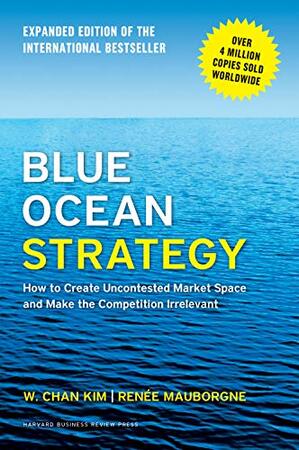
Blue ocean strategy
Reconstruct Market Boundaries
Reconstructing market boundaries is the first principle of blue ocean strategy, a concept introduced by W. Chan Kim and Renée Mauborgne. Instead of competing within existing industry norms, organizations should boldly explore new horizons and break away from conventional limits. Rather than adhering to the status quo, companies should adopt a fresh perspective and look beyond the traditional boundaries set by the industry. They should consider areas that have been overlooked or unexplored and identify unmet needs. The key lies in understanding customer pain points and gaps to discover new opportunities. Blue ocean strategy encourages venturing into uncharted waters, exploring markets that are not part of the industry’s typical scope. Companies should challenge industry norms and assumptions by redefining their target audience, offering different value propositions, and changing the way they deliver products or services. By reconstructing market boundaries, companies can create new demand, addressing unmet needs, and providing unique value propositions. The goal is to escape the red ocean of fierce competition and sail into the blue ocean of untapped opportunities, charting a course toward innovation and growth. This process involves identifying and leveraging the factors that differentiate a company’s offerings from those of its competitors, thereby creating a new market space with ample opportunity for profitable growth.
Focus on the Big Picture, Not the Numbers
In the pursuit of creating blue oceans, organizations must resist the allure of short-term profits and financial metrics. Instead, they should adopt a strategic mindset that prioritizes long-term value creation for customers. Rather than being myopically focused on immediate gains, successful blue ocean strategies encourage leaders to think beyond quarterly reports. They should consider the broader horizon and the lasting impact of their decisions, understanding industry trends, customer needs, technological shifts, and societal changes. While financial metrics are essential, blue ocean strategies emphasize value creation—how well an organization meets customer needs and solves their problems. Leaders must articulate a compelling strategic vision that extends beyond profit margins, guiding decision-making and balancing short-term and long-term goals. By focusing on the big picture and understanding the broader context, organizations can successfully navigate these uncharted waters. This approach entails looking beyond just financial performance to encompass factors such as brand reputation, customer loyalty, and overall market influence. In essence, it’s about building sustainable competitive advantage by creating meaningful value for customers and stakeholders alike, rather than solely chasing short-term financial gains.
Reach Beyond Existing Demand
Extending beyond the boundaries of existing demand is the third principle of blue ocean strategy, a concept developed by W. Chan Kim and Renée Mauborgne. Rather than confining themselves to their current customer base, organizations should boldly explore untapped markets. Blue ocean strategies encourage companies to look beyond their existing clientele and target non-customers—individuals or groups who have not yet engaged with the industry’s offerings. By reaching out to these non-customers, companies can tap into latent demand, unlocking new growth opportunities. This process involves scaling risk attenuation, allowing organizations to mitigate the scale risk associated with creating a new market while aggregating the greatest demand for their new offerings. By targeting non-customers and unlocking new demand, companies can sail into uncharted waters and discover growth opportunities that were previously unseen. This strategic shift from focusing solely on existing demand to reaching beyond it not only expands the company’s market reach but also stimulates innovation and fosters long-term growth. It’s about creating blue oceans of uncontested market space where competition becomes irrelevant, enabling companies to capture new value and secure their position in the marketplace.
Get the Strategic Sequence Right
Sequencing actions strategically is the fourth principle of blue ocean strategy, as outlined by W. Chan Kim and Renée Mauborgne. By following the right sequence, companies can effectively navigate the uncharted waters of creating a blue ocean. The process begins with a thorough assessment of buyer utility, where organizations focus on creating a leap in net buyer value by identifying and addressing unmet needs and solving problems in a unique and compelling way. Strategic pricing comes next, aiming to set prices that are both compelling to customers and aligned with the value provided, thereby creating irresistible demand. Simultaneously, careful consideration of costs is essential to ensure that the target cost can be met while still allowing for a healthy profit margin. Profitability ultimately hinges on striking the right balance between value creation and cost management, with a commitment to innovation to hit the target cost if necessary. Moreover, anticipating and addressing adoption hurdles proactively is crucial to ensuring the successful rollout of the new offering. By aligning their actions with this strategic sequence, companies can effectively bring to life a commercially viable blue ocean idea, setting themselves apart from the competition and unlocking new avenues for sustainable growth and success in the marketplace.
Overcome Key Organizational Hurdles
Overcoming key organizational hurdles is essential for successfully implementing blue ocean strategy, a concept articulated by W. Chan Kim and Renée Mauborgne. This process encompasses fostering a culture of innovation, risk-taking, and openness to change within the organization. It requires ensuring alignment among leadership teams to effectively drive the strategy forward. Additionally, strategic reallocation of resources is crucial to support the initiatives associated with creating a blue ocean. Effective change management practices must be employed to navigate the transition smoothly. Developing the necessary skills among employees is vital to executing the strategy effectively and realizing its full potential. Moreover, overcoming resistance to change is a significant challenge that must be addressed through communication, engagement, and incentives. In summary, creating a blue ocean requires not only strategic thinking but also organizational agility, cultural transformation, and effective leadership to overcome these hurdles and pave the way for innovation and sustainable growth.
Build Execution into Strategy
Building execution into strategy is crucial for turning a blue ocean vision into reality, as emphasized in the principles of blue ocean strategy developed by W. Chan Kim and Renée Mauborgne. This process involves more than just formulating a strategic plan; it requires ensuring strategic alignment throughout the organization. Clear objectives and metrics must be defined to measure progress effectively and guide decision-making. Resources must be allocated strategically to support the initiatives associated with creating a blue ocean. Fostering cross-functional collaboration is essential to leverage diverse expertise and perspectives within the organization. Effective risk management practices must be in place to mitigate potential challenges and uncertainties along the way. Securing buy-in from stakeholders through clear communication and engagement is critical to garner support and alignment behind the strategy. Being agile in implementation allows organizations to adapt to changing circumstances and seize emerging opportunities effectively. Change leadership is vital to guide the organization through the transformation process and inspire commitment to the vision. Testing elements through pilot projects enables organizations to validate assumptions and refine strategies before full-scale implementation. Continuous learning and improvement are essential to ensure that the organization remains responsive to evolving market dynamics and customer needs. By embedding execution considerations from the outset and integrating them seamlessly into the strategic planning process, organizations can create new market spaces and leave competitors behind, positioning themselves for long-term success and growth.












